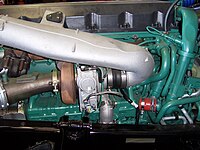
Photo from wikipedia
When the femtosecond laser pulse is comparable to the electron relaxation time, the hyperbolic effect cannot be neglected in heat transfer analysis. The non-Fourier effect is considered for heat transfer… Click to show full abstract
When the femtosecond laser pulse is comparable to the electron relaxation time, the hyperbolic effect cannot be neglected in heat transfer analysis. The non-Fourier effect is considered for heat transfer analysis assuming finite delay in the development of temperature within the body. This delay is represented in terms of two relaxation times connected to heat flux and temperature gradient. In the present work, a 3D finite element-based heat transfer model is developed using a dual-phase-lag effect. Since the experimental basis of transient temperature distribution in ultrashort pulse laser is extremely difficult or nearly impossible, the model results have been validated with the literature reported results. Furthermore, the simulation of dissimilar fusion welding system treated by an ultrashort pulse laser is demonstrated. The typical characteristic of thermal behavior with the application of femtosecond fiber laser on welding of dissimilar aluminum alloy and stainless steel is presented. The model results in the form of computed isotherm are compared with the literature reported weld pool geometry for dissimilar materials. The feasibility of characteristic parameters like pulse frequency, pulse width, and relaxation times are assessed in this study. A clear guideline of the geometric shape and size of weld pool geometry and the peak temperature of the welding system corresponding to predictable laser parameters is the effective output from this study. Peak temperature reached in a very short interval of time (∼ nanosecond) is analogous to a high rate of heating or cooling that affects the microstructural changes, specifically the formation of intermetallic for dissimilar welding.
Journal Title: Journal of Thermal Science and Engineering Applications
Year Published: 2020
Link to full text (if available)
Share on Social Media: Sign Up to like & get
recommendations!